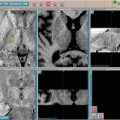© Springer Science+Business Media New York 2015
Lawrence S. Chin and William F. Regine (eds.)Principles and Practice of Stereotactic Radiosurgery10.1007/978-1-4614-8363-2_1616. Metastatic Brain Tumors: Viewpoint: Whole Brain Radiation Therapy
(1)
Department of Radiation Oncology, University of Maryland Medical Center, 22 South Greene Street, Baltimore, MD 21201, USA
(2)
National Brain Tumor Center, Capital Institute for Neurosciences, Capital Health Medical Center-Hopewell, Two Capital Way, Suite 456, Pennington, NJ 08534, USA
Introduction
Whole-brain radiation therapy (WBRT) is the mainstay of treatment for most patients with intracerebral metastases. It is useful for most newly diagnosed tumors and sometimes also as salvage therapy for recurrent tumors.
Efficacy of WBRT
Given the general consensus that WBRT is an effective treatment for brain metastases, it is surprising to note that there have been limited randomized data comparing WBRT with best supportive care or no treatment [1]. To our knowledge, only one randomized trial (performed in the pre-computed tomography era) has evaluated the addition of WBRT to supportive care [2]. In this trial, 48 patients with presumed brain metastases were randomized to steroids with or without 40 Gy WBRT. Although p-values were not given, the addition of WBRT led to improved duration of remission as well as median survival (14 vs. 10 weeks). Additional support for the general efficacy of WBRT comes from comparing the outcomes of patients after WBRT treatment with the natural history of untreated brain metastases. Data from large retrospective studies [1, 3, 4] have shown that WBRT increases the median survival time to 3–6 months and that more than half of patients treated with WBRT die ultimately of progressive systemic cancer and not as a direct result of brain metastases. This contrasts with the natural history of untreated patients, which is that patients live for a median of 1–2 months and virtually all die as result of their brain lesions [2, 5–7]. There is little doubt that WBRT does control or improve symptoms, at least temporarily, in the majority of patients with brain metastases. Responses to radiation can be seen early in the treatment course, with 50 % of patients experiencing an improvement in neurologic symptoms by the second week of treatment [8]. Overall, the clinical and radiographic response to brain radiation ranges from 50 to 75 % [9]. Ultimately, the primary goals of the management of the patient with brain metastases are to provide effective palliation, improve quality of life and, if at all possible, extend survival. To these ends, stereotactic radiosurgery (SRS) and whole brain radiation therapy (WBRT) are effective treatment modalities that often play a significant role in the management of brain metastases. Although sometimes thought to be competing modalities, they are, in fact, quite complementary; SRS delivers ablative radiation doses with a high degree of precision (typically in one fraction), whereas WBRT delivers lower amounts of radiation to the entire brain parenchyma (typically over the course of weeks). The former is more effective in treating clinically visible tumor deposits, whereas the latter treats microscopic foci of disease and each has been shown to improve outcomes in specific settings.
Unsettled Issues
Although there is general agreement on efficacy, no consensus exists on the optimum WBRT dose and schedule for the treatment of brain metastases. The best available data on the effect of dose and schedule for the treatment of brain metastases comes from several large-scale multi-institutional trials conducted by the Radiation Therapy Oncology Group (RTOG) [1, 8, 10–12]. These studies have shown no significant difference in the frequency and duration of response for total radiation doses ranging from 2,000 cGy over 1 week to 5,000 cGy over 4 weeks. Regimens of 1,000 cGy in a single dose or 1,200 cGy in two doses were less effective and are no longer in use. Typical radiation treatment schedules for brain metastases consist of short courses (7–15 days) of WBRT with relatively high doses per fraction (150–400 cGy per day) and total doses in the range of 3,000–5,000 cGy. These schedules minimize the duration of treatment while still delivering adequate amounts of radiation to the tumor.
Attempts to Improve WBRT
Different fractionation and dosing schemes have been tried in order to improve the effectiveness of WBRT with varying results. Epstein et al. [13] reported a phase I/II dose-escalation study of hyperfractionated radiotherapy using total doses of 48, 54.4, 64, and 70.4 Gy. No increased toxicity was identified and the three highest dose arms had a statistically significant improvement in median survival over the lowest dose arm. This study suggested a dose-dependent effect with the use of hyperfractionated radiation in unresected, single brain metastasis. Unfortunately, a large randomized RTOG trial, studying both single and multiple brain metastases, failed to show improvement in overall survival using a hyperfractionated schedule of 54.5 Gy in 34 fractions compared with a standard regimen of 30 Gy in 10 fractions [14].
Similarly, multiple randomized trials have failed to identify a benefit to the addition of radiosensitizers or chemotherapy to WBRT [9]. Investigators, nonetheless, continue to search for drugs that will improve the therapeutic ratio between normal brain tissue and tumor cells.
Complications of WBRT and the Concern for Neurotoxicity
WBRT has complications. Almost all patients experience a temporary loss of hair; although hair growth usually resumes 6–12 months after completing therapy. Also, in the short-term, patients may have a transient worsening of neurologic symptoms while receiving therapy. Many physicians believe that maintaining patients on steroids during radiotherapy will minimize radiation complications, although conclusive proof of this has not been forthcoming. The long-term side effects of radiotherapy are usually not a significant issue in the treatment of patients with brain metastases because of the relatively short survival time of these patients.
When discussing neurotoxicity, it is important to note that nearly all patients with brain metastases present with neurocognitive deficits prior to beginning WBRT [15]. Meyers et al. reported the most extensive study evaluating neurocognitive function for patients with brain metastases. This detailed work examined neurocognitive function in patients with brain metastases randomized to WBRT with or without the radiation sensitizer, Motexafin Gadolinium. 401 patients were enrolled and each patient underwent a battery of eight neurocognitive function tests at baseline and following treatment. At baseline, 91 % of patients had a deficit, and 42 % had deficits seen in four or more tests. Lesion volume was predictive of initial neurocognitive deficit. This data is critical as most studies do not describe baseline neurocognitive deficits. Not only does recurrence of intracranial disease result in significant symptoms, it is also one of the most important predictors of neurocognitive dysfunction. Meyers et al. also noted a correlation between tumor progression and worsening neurocognitive function [16]. Following treatment, patients with tumor shrinkage at 2 months greater than the population median had improved survival as well as a longer time to neurocognitive dysfunction. Patients with a partial response also had an improvement in execution function and visual motor scanning from baseline. In comparison, patients with progressive disease had a significant worsening of neurocognitive symptoms.
One often quoted retrospective study by DeAngelis et al. [17] suggests that as many as 11 % of long-term survivors (>12 months) of brain metastases treated with WBRT develop dementia. However, virtually all of the patients in that sample who developed dementia had been treated with atypically large radiation fractionation schedules. The patients treated with fraction sizes of 3.0 Gy or less per day did not develop clinically apparent dementia. Thus, the actual frequency of radiation-related dementia when using convention fractionation schedules is not known, but is certainly less than 11 %. In any event, the frequency of long-term neuropsychological side effects of WBRT in adult brain metastases patients appears to have been overestimated and seems to be within the acceptable range when modern fractionation schemes are employed. As such, the question is not whether WBRT alone results in any neurotoxicity, but rather whether its overstated risks are outweighed by the benefits of reduced intracranial failure with associated neurocognitive dysfunction. In our view it generally is. When discussing the pros and cons of WBRT with patients, it is important that the physician maintains appropriate perspective regarding the toxicities associated with WBRT. For instance, recently, there has been accumulating data suggesting that many systemic chemotherapies are associated with long-term neurotoxicities [18, 19]. That is not to say that all chemotherapy need be abandoned, but rather whenever prescribing treatment, one must make sure that the benefits outweigh the risks.
WBRT With or Without SRS in the Treatment of Brain Metastases
Because the majority of patients have multiple metastases, the efficacy data for WBRT comes in a large part from treatment of patients with multiple brain metastases. There is little doubt that WBRT is effective for multiple metastases, and it is used routinely. The main controversy regarding the treatment of multiple metastases involves the use of radiosurgery (either with or without WBRT).
To date, there have been two randomized trials [20, 21] assessing the efficacy of radiosurgery in the treatment of multiple metastases. The first randomized trial was reported by Kondziolka et al. [20]. In that study, 27 patients with multiple brain metastases were randomized to treatment with WBRT alone or WBRT plus a radiosurgery boost. The study was stopped early because the authors claimed to have found a large difference in the recurrence rates in favor of radiosurgery. Unfortunately, the study used nonstandard end points to measure recurrence. The investigators used any change in measurement of the lesion rather than the more usual 25 % increase in diameter. No attempt was made to control for steroid use, radiation changes, or other factors that might produce small fluctuations in lesion size on magnetic resonance imaging (MRI). Also, as a study with only 27 patients, it lacked the statistical power to support any meaningful conclusion, regardless of p values. As a result, this study was uninterpretable.
A second study was reported by Andrews et al. [21]. This study (RTOG 9508) contained 333 evaluable patients with one to three brain metastases who were randomized to treatment with either WBRT (37.5 Gy) plus radiosurgery or WBRT (37.5 Gy) alone. The primary end point was survival. Overall, there was no significant difference in survival between the two treatment groups (median, 6.5 months for radiosurgery plus WBRT and 5.7 months for WBRT-alone, p = 0.1356). There was no survival benefit from radiosurgery in patients with multiple metastases (median, 5.8 months for radiosurgery plus WBRT and 6.7 months for WBRT-alone, p = 0.9776). (However, for patients with single metastases, there was a significant survival advantage favoring radiosurgery, median 6.5 months vs. 4.9 months, p = 0.0393). Lower posttreatment Karnofsky scores and steroid dependence were more common in the WBRT-alone group. Multiple subgroup analyses were performed, and a benefit for radiosurgery plus WBRT was found in several subgroups that included patients with single and multiple metastases. These subgroups were RPA class 1 patients, patients with metastases size equal to or larger than 2 cm, and lung cancer patients with squamous cell histology. However, these subset analyses were not prespecified, and the p values needed for significance should have been adjusted for inflation of type I error. When this was done, none of these subgroup analyses showed a positive benefit for radiosurgery [22]. So, for multiple brain metastases, this was a completely negative trial with regard to the major end points prevention of death due to neurologic causes and overall survival.
Radiosurgery has been put to the test in the treatment of multiple metastases and has not been established as effective. Therefore, based on the best available evidence, WBRT-alone is the treatment of choice for most patients with multiple brain metastases (and the word “multiple” in this context means more than one).
Adjuvant WBRT in Conjunction with Focal Treatment of Brain Metastases
For the treatment of single brain metastases, randomized trials have established the superiority of focal treatment (either conventional surgery or radiosurgery) plus WBRT over treatment with WBRT-alone. Therefore, good-prognosis patients with single brain metastases should be treated with upfront surgery or radiosurgery. However, with the establishment of the efficacy of focal treatments for single brain metastases, a new controversy has arisen as to whether adjuvant WBRT is really necessary after a “complete resection” or “successful” treatment with radiosurgery. Adjuvant WBRT is thought to be of benefit because there may be residual disease in the tumor bed or at distant microscopic sites in the brain. However, brain metastases tend to be discrete masses that are theoretically capable of being removed totally or destroyed, and so WBRT may not be necessary after “successful” focal therapy.
There are several reasons for eliminating WBRT. First, WBRT has adverse, long-term neuropsychological side effects. Second, there are also the costs and time commitment of the patient that must be considered. And finally, there is the possibility that WBRT may simply not be needed at all. It is theoretically possible to completely remove single brain metastases by surgery, or to control them with radiosurgery. Furthermore, neuroimaging has improved, and it may now be possible to detect reliably additional metastases that may be present and treat these with additional focal therapy. If these last two statements are true, then there would be little justification for adjuvant WBRT.
On the other hand, compelling reasons exist for giving adjuvant WBRT. As a practical matter, it is likely impossible to completely remove all metastases with conventional surgery, and radiosurgery does not completely control multiple tumors. In addition, neuroimaging may not have reached the point yet where we can be absolutely certain that all metastases are being detected, and therefore some type of additional treatment may be needed. Also, although WBRT does have side effects, these side effects may not be as severe or as common as was previously thought. Furthermore, most patients with brain metastases have relatively limited overall survival times, and so the really serious long-term side effects are usually not an issue in their care.
Randomized trials [23–25] have addressed the question of adjuvant WBRT in conjunction with focal treatment. A study published in 1998 by Patchell et al. [23] examined the effect of WBRT in conjunction with conventional surgery. In that study, 95 patients who had single brain metastases that were completely surgically resected were randomized to treatment with postoperative WBRT (50.4 Gy) or to observation with no further treatment of the brain metastasis (until recurrence). Recurrence of tumor anywhere in the brain was less frequent in the radiotherapy group than in the observation group (18 % vs. 70 %, p < 0.001). Postoperative radiotherapy prevented brain recurrence at the site of the original metastasis (10 % vs. 46 %, p < 0.001) and at other sites in the brain (14 % vs. 37 %, p < 0.01). As a result, patients in the radiotherapy group were less likely to die of neurologic causes than patients in the observation group (6 of 43 who died [14 %] vs. 17 of 39 [44 %]; p = 0.003). There was no significant difference between the two groups in overall length of survival or the length of time that patients remained functionally independent.
The effect of WBRT in association with radiosurgery was examined in a randomized trial conducted by the Japanese Radiation Oncology Study Group and reported in abstract form by Aoyama et al. [24]. In that study, 132 patients with one to four brain metastases were randomized to treatment WBRT plus radiosurgery or with radiosurgery-alone. The WBRT total dose was 30 Gy. The radiosurgery dose was 18–25 Gy at the periphery of the lesion in the radiosurgery-alone group and was reduced by 30 % in the WBRT plus radiosurgery group. The median survival time was 7.5 months in the WBRT plus radiosurgery group and 8.0 months in the radiosurgery-alone group, p = 0.42. The 12-month brain metastases recurrence rates were significantly (p < 0.001) different (47 % in the WBRT plus radiosurgery group and 76 % in the radiosurgery-alone group). Death due to neurologic causes and neurologic functioning were not significantly different between the two groups.
Despite the fact that both of the randomized trials [23, 24] showed clearly that WBRT prevented recurrences, these studies have actually provoked controversy rather than settling the issue. Results of these trials have been used as reasons both to give and not to give adjuvant WBRT. The justification for not giving WBRT holds that because no survival difference was found in either of the trials, WBRT really adds nothing to the treatment. This argument fails on several counts.
The Patchell study [23] used tumor recurrence as the primary end point and was not designed either to show a difference in survival or to rule one out. There was actually an increase of 11 % in survival time in the WBRT group when compared with the observation group. The relative risk of improved survival with WBRT was 1.1. However, this was not a statistically significant difference. Because there was a statistically significant reduction in death due to neurologic causes, ultimately adjuvant WBRT might have had some positive impact on overall survival time. The estimated sample size required to detect a significant difference of 11 % in overall survival with adequate power would have been 1,005 patients per group or 2010 patients total. For practical reasons, the study could not be designed to have this large of a sample size and, therefore, was not designed to detect moderate differences in survival, even one as large as 11 %.
Stay updated, free articles. Join our Telegram channel

Full access? Get Clinical Tree







